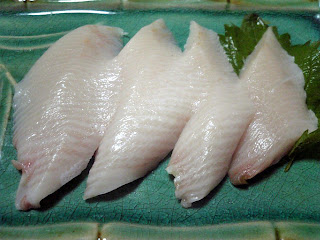
This is a Japanese deep-fried chicken.
("tatsuta-age" means a Japanese deep-fried technic.)
It is similar to "
Tori no kara-age".
Different point of them are
(1) In case of tatsuta-age chicken, chicken pieces are soaked in sauce, before those are coated with potato starch.
(2)In case of tatsuta-age, chicken pieces are coated with potato starch.
In case of kara-age, chicken pieces are coated with potato starch or wheat flour.
(3)tatsuta-age chicken is not cooked with garlic.
So I think tatsuta-age chicken is more Japanese.
We usually cut chicken leg into bite size.
Put chicken pieces into sauce which is mixed with soy sauce, sake and grated ginger( or ginger juice), and keep it around in 20 min.
Take chicken pieces out, and dry them with paper towel.
Coat them with potato starch, and deep-fry.




























